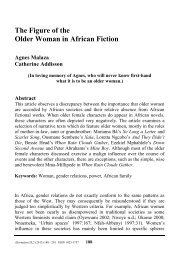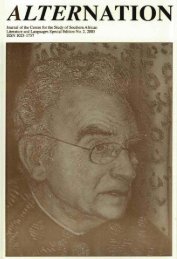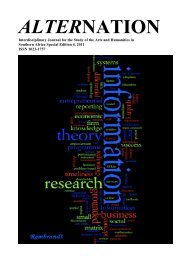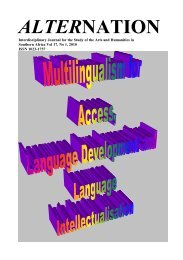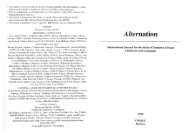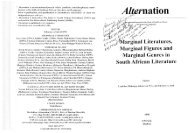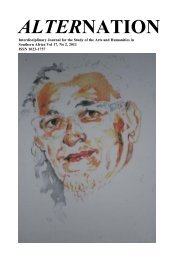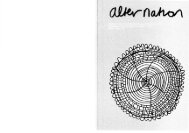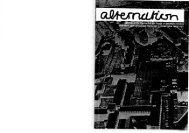Re-reading The Purloined Letter - Alternation Journal
Re-reading The Purloined Letter - Alternation Journal
Re-reading The Purloined Letter - Alternation Journal
You also want an ePaper? Increase the reach of your titles
YUMPU automatically turns print PDFs into web optimized ePapers that Google loves.
385<br />
<strong>Re</strong>-<strong>reading</strong> <strong>The</strong> <strong>Purloined</strong> <strong>Letter</strong><br />
mind to find the mental state that corresponds to the physiognomic set.<br />
According to Juliet Flower and Mac Cannell (1986:31), Lacan’s response to<br />
such an explanation is to demystify it:<br />
We are, then, Lacan says, in the realm of symbolic signification: that<br />
of the ‘plus-moins’ and the ‘moins-plus’, not in the realm of the real,<br />
where in a random series ‘at each throw, you have as many chances<br />
of winning or losing as on the previous throw’. <strong>The</strong> coins tossed in<br />
the game are re-marked with a signifier of their value not as coins,<br />
but as ‘odd’ or ‘even’…. And in this region of the symbol, it is two<br />
that is the odd number. Johnson points out that what Lacan is trying<br />
to think through here is not the eternal (Oedipal) triangle, not the<br />
number One, but the number two. But she does not offer us the<br />
reason why. On the one hand, Lacan re-emphasizes the purely<br />
imaginary character of the binary, dual relation once the symbolic<br />
holds sway. But on the other, he evokes the idea that the two might<br />
be thought outside the confines of the symbolic.<br />
Flower and Cannell (1985:32) observed that Barbara Johnson misses one<br />
trick in Lacan’s seminar on <strong>The</strong> <strong>Purloined</strong> <strong>Letter</strong>, where we find the<br />
meaning of the ‘two’ Lacan is trying to rescue for the first time. Because<br />
Johnson is not attending to the importance of the form of the social tie in<br />
Lacan, she overlooks the major question Lacan’s text leads up to, asking of<br />
the hegemony of the signifier, a hegemony which he himself so amply<br />
illustrates: the question of the heterosexual relation. In the Poe story, this is<br />
the King and the Queen’s relation. To get to that relation we need to return<br />
to Lacan. He has distinguished in the seminar between two registers. <strong>The</strong><br />
first register is that of ‘exactitude’ of measurement, of accuracy. This<br />
register appears in the Compte <strong>Re</strong>ndu of the affair given by the Prefect of the<br />
Police. His narrative depends, contend Flower and Cannell (1986:18), on its<br />
exactitude being ‘guaranteed’ by his neutrality. He is merely a messenger, a<br />
means of ‘linguistic transmission’. <strong>The</strong> other register is that of ‘truth’, the<br />
narrative register which invests Dupin with all manner of ambiguities,<br />
aporias and enigmas. Here ‘truth’ is given a gender: it is a ‘woman’. (I will<br />
explore this further when discussing Derrida’s critique of Lacan). <strong>The</strong>re is,<br />
however, another woman in <strong>The</strong> <strong>Purloined</strong> <strong>Letter</strong>: the Queen. She appears



